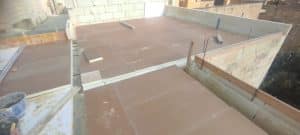Underfloor heating has been gaining popularity in Malta, especially among homeowners looking for an efficient, comfortable, and aesthetically pleasing way to heat their homes. When paired with tiled floors, it can deliver exceptional warmth and style—but like any home improvement, it’s not without its trade-offs.
In this guide, we’ll explore the pros and cons of underfloor heating on tiles in detail so you can make an informed decision before investing. Whether you’re building a new home or renovating an existing one, this comprehensive breakdown will help you weigh the benefits against the drawbacks.
What Is Underfloor Heating and Why Tiles Are Popular in Malta| Pros and Cons of Underfloor Heating on Tiles
Underfloor heating is a system that uses electric heating mats or water-filled pipes installed beneath the floor to provide warmth. Instead of relying on radiators or air vents, it gently radiates heat from below, ensuring even temperature distribution. (Learn more about the science behind underfloor heating here.)
In Malta, tiled floors are extremely common due to their durability, cooling properties in summer, and timeless style. Ceramic, porcelain, and natural stone tiles not only look great but also work brilliantly with underfloor heating because they conduct heat efficiently. This makes the combination of underfloor heating and tiles both practical and luxurious.
The 7 Pros and Cons of Underfloor Heating on Tiles| Pros and Cons of Underfloor Heating on Tiles
Before you commit, let’s break down the major advantages and disadvantages so you can see the full picture.
1. Pro: Exceptional Heat Efficiency and Comfort| Pros and Cons of Underfloor Heating on Tiles
One of the top advantages of underfloor heating on tiles is the level of comfort it offers. Tiles are excellent conductors of heat, meaning the warmth generated from beneath is transferred quickly and evenly across the entire floor surface.
Unlike traditional heating systems that create hot spots near radiators and cooler areas farther away, underfloor heating keeps the temperature consistent in every corner of the room. This makes walking barefoot a pleasure—even in Malta’s cooler winter months.
Additionally, the efficiency of tile as a heat conductor means you may achieve your desired room temperature faster, potentially reducing your overall energy consumption and heating costs over time.
2. Pro: Space-Saving and Aesthetic Freedom| Pros and Cons of Underfloor Heating on Tiles
Underfloor heating eliminates the need for radiators or bulky heating units, freeing up valuable wall and floor space. For modern interiors, this opens up endless design possibilities—no more having to arrange furniture around a radiator or worry about blocking airflow.
When installed under tiles, the system is completely hidden, so your flooring looks sleek and uninterrupted. This is especially appealing for minimalist or contemporary Maltese homes where open, uncluttered spaces are highly valued.
3. Pro: Low Maintenance Once Installed| Pros and Cons of Underfloor Heating on Tiles
Once professionally installed, underfloor heating systems (especially electric ones) require very little maintenance. There are no moving parts that need regular servicing, and with proper installation under tiles, the system can last decades without issues.
Water-based underfloor heating may require occasional maintenance, but when paired with tiles—which protect the pipes or cables from damage—the risk of problems is greatly reduced.
4. Con: Higher Upfront Installation Costs| Pros and Cons of Underfloor Heating on Tiles
Here’s where the balance starts to tip: installing underfloor heating under tiles isn’t the cheapest option. In Malta, you can expect to pay anywhere from €60 to €90 per square metre for electric underfloor heating, and €100 to €150 per square metre for water-based systems, including materials and installation.
If you’re also replacing your tiles, you’ll need to factor in the cost of tile removal, preparation, and laying new tiles—bringing the total cost for a medium-sized room into the range of €2,000–€4,000 or more.
While this is a considerable investment, many homeowners see it as worthwhile due to the comfort, energy efficiency, and property value increase it brings.
5. Con: Longer Warm-Up Time Compared to Radiators| Pros and Cons of Underfloor Heating on Tiles
While tiles are great at holding heat once they warm up, the initial heating process can take longer than other methods, especially in larger rooms or in homes without strong insulation.
If you’re used to instantly turning on a radiator and feeling warmth within minutes, underfloor heating may require an adjustment period. On average, it can take 30–90 minutes for tile floors to reach the desired temperature, depending on the system type and room conditions.
This means you’ll get the best experience if you use a programmable or smart thermostat to preheat the space before you need it—so it’s warm when you wake up or return home.
6. Pro: Even Heat Distribution That Feels Natural| Pros and Cons of Underfloor Heating on Tiles
Traditional heating systems heat the air unevenly, often leaving your head warm but your feet cold. Underfloor heating solves this by delivering warmth exactly where you feel it most—your feet—and allowing it to rise evenly through the room.
Tiles enhance this effect because they spread the heat uniformly without hot or cold patches. This creates a natural, cosy environment without the dryness that can come from forced-air systems.
7. Con: Complex Installation for Existing Homes| Pros and Cons of Underfloor Heating on Tiles
While adding underfloor heating under tiles is straightforward during new construction, retrofitting it into an existing home is more complicated.
The process usually involves removing the existing flooring, levelling the subfloor, installing the heating system, and then relaying the tiles. This can add days or even weeks to your renovation schedule and will likely make the project more expensive.
If your current floors are in good shape but you want underfloor heating, it may still be possible to install a low-profile electric mat system directly under new tiles without raising the floor too much—but you’ll need professional advice to ensure compatibility.
Cost Considerations in Malta| Pros and Cons of Underfloor Heating on Tiles
When evaluating the pros and cons of underfloor heating on tiles, budget is often a deciding factor. Here’s a quick breakdown of what you might expect to spend in Malta:
| Item | Estimated Cost (€) |
|---|---|
| Electric heating mats (per m²) | €60–€90 |
| Water-based systems (per m²) | €100–€150 |
| Tile removal & preparation (per m²) | €20–€40 |
| New tile supply & installation (per m²) | €30–€80 |
| Smart thermostat | €100–€300 |
While underfloor heating is more expensive upfront than a traditional radiator system, the combination with tiles means you’ll have a system that is efficient, durable, and virtually invisible—adding both comfort and value to your property.
Energy Efficiency and Long-Term Savings| Pros and Cons of Underfloor Heating on Tiles
One often-overlooked benefit in the pros and cons of underfloor heating on tiles discussion is the potential for long-term savings.
Because tiles are excellent heat conductors, the system can run at lower temperatures compared to radiators while delivering the same comfort level. This can help reduce energy usage, particularly if paired with a smart thermostat that optimises run times.
In Malta’s relatively mild winters, this means you won’t need to run the system at full power for long periods, keeping electricity or gas bills manageable.
Comfort vs. Cost: Striking the Right Balance| Pros and Cons of Underfloor Heating on Tiles
The decision to install underfloor heating under tiles often comes down to personal priorities. If you value consistent warmth, a sleek look, and low maintenance, the pros may far outweigh the cons.
However, if you’re on a tight budget or don’t want the disruption of installation in an existing home, you may prefer to stick with traditional heating—or install underfloor heating only in high-use areas like bathrooms and kitchens.
Perfect — let’s wrap up the second half of your “7 Key Pros and Cons of Underfloor Heating on Tiles” blog post.
Choosing the Best Tiles for Underfloor Heating| Pros and Cons of Underfloor Heating on Tiles
Not all tiles are created equal when it comes to underfloor heating. While most ceramic, porcelain, and stone tiles are excellent conductors, some types perform better than others.
Porcelain Tiles – Highly durable, water-resistant, and excellent at heat conduction. They are ideal for both bathrooms and open-plan living spaces.
Natural Stone Tiles – Materials like marble, slate, or limestone retain heat for a long time, offering a luxurious feel. However, they may require sealing to protect against moisture.
Ceramic Tiles – A more affordable option that still offers good heat transfer, making them suitable for kitchens, hallways, and dining areas.
When deciding, also consider tile thickness. Thicker tiles will take longer to warm up but will retain heat longer, while thinner tiles heat quickly but may cool down faster.
Common Mistakes to Avoid| Pros and Cons of Underfloor Heating on Tiles
Even if you understand the pros and cons of underfloor heating on tiles, small installation errors can undermine performance. Here are the most common pitfalls:
Skipping Proper Insulation – Without insulation boards beneath your heating system, a large portion of heat may be lost downward, increasing running costs.
Incorrect Thermostat Setup – Failing to program the system effectively can lead to unnecessary energy consumption.
Using Incompatible Adhesives – Not all tile adhesives and grouts are suitable for underfloor heating. Always choose flexible, heat-resistant products.
Poor Floor Preparation – Uneven subfloors can cause tiles to crack under temperature changes.
Working with an experienced installer in Malta is key to ensuring your system performs optimally for years to come.
Maintenance Tips for Underfloor Heating on Tiles| Pros and Cons of Underfloor Heating on Tiles
The good news? Once installed correctly, maintenance is minimal. Still, there are a few practices that will help maximise lifespan:
For Electric Systems – Perform a quick check of your thermostat and controls before winter each year to ensure everything is functioning.
For Water-Based Systems – Have a technician check for leaks or pressure drops every few years, especially in older systems.
Tile Care – Clean tiles with pH-neutral products to avoid damaging grout or stone finishes. This won’t affect the heating but will keep your floors looking their best.
Is Underfloor Heating Worth It for Maltese Homes?| Pros and Cons of Underfloor Heating on Tiles
The combination of tiles and underfloor heating suits Malta’s climate well. While winters are not as severe as in Northern Europe, the mild chill can still make tiled floors uncomfortably cold. Underfloor heating turns them into a source of comfort, making your home more enjoyable in the cooler months.
When weighing the pros and cons of underfloor heating on tiles, remember that the value isn’t just in warmth—it’s also in aesthetics, space savings, and potential long-term energy efficiency.
How Underfloor Heating Enhances Property Value in Malta| Pros and Cons of Underfloor Heating on Tiles
Beyond comfort, underfloor heating can also boost the value of your home. In Malta’s competitive real estate market, luxury features like warm tiled floors stand out to potential buyers. Many see it as a sign of high-quality construction and modern living standards, which can make your property more appealing and easier to sell. While the upfront investment may feel significant, it can pay off in both daily enjoyment and future resale potential.
Ideal Rooms for Underfloor Heating Under Tiles| Pros and Cons of Underfloor Heating on Tiles
Although underfloor heating works in almost any tiled space, some areas benefit more than others. Bathrooms and ensuites are top choices, as warm floors feel especially luxurious after a shower. Kitchens are another great location, as they’re high-traffic areas where people often stand for long periods. Living rooms and open-plan spaces can also benefit, especially when paired with large-format tiles for maximum heat distribution.
Pairing Underfloor Heating with Smart Home Technology| Pros and Cons of Underfloor Heating on Tiles
Modern underfloor heating systems can easily be integrated with smart thermostats and home automation tools. This allows you to set schedules, control heating remotely, and optimise energy use based on your daily habits. For example, you can program the system to start heating your tiled floors 45 minutes before you wake up, ensuring they’re perfectly warm without wasting energy during the night.
The Environmental Impact| Pros and Cons of Underfloor Heating on Tiles
One of the lesser-discussed benefits in the pros and cons of underfloor heating on tiles conversation is its eco-friendly potential. Because it operates at lower temperatures compared to traditional radiators, underfloor heating can reduce overall energy consumption—especially when paired with renewable energy sources like solar panels. For Malta, with its abundant sunshine, this can be a powerful combination that lowers your carbon footprint while keeping your home comfortable.
Customising the System for Your Needs| Pros and Cons of Underfloor Heating on Tiles
Underfloor heating isn’t a one-size-fits-all solution. The type of system—electric or water-based—should be chosen based on your property’s layout, insulation levels, and intended usage. For smaller tiled areas or renovations, electric systems are often the most convenient. For larger spaces or new builds, water-based systems might be more cost-effective over time. A professional assessment can help you determine the best setup for your home.
Why Professional Installation Matters
Even the best underfloor heating system will underperform if it’s installed incorrectly. Working with certified installers in Malta ensures that the system is correctly insulated, the heating mats or pipes are laid evenly, and all materials are compatible with the chosen tiles. This not only protects your investment but also ensures maximum efficiency, safety, and longevity for your new heated floors.
Summary Table: Pros and Cons at a Glance
| Pros | Cons |
|---|---|
| Even, consistent heat | Higher upfront installation cost |
| Comfortable warm floors | Longer warm-up times |
| Space-saving design | Complex retrofit installation |
| Low maintenance | Requires careful installation |
| Works perfectly with tiles | Dependent on good insulation |
Final Thoughts
Underfloor heating on tiles is a premium home upgrade—one that blends functionality, comfort, and style. If you plan to renovate or build, and you want heating that is invisible yet effective, it’s an investment worth serious consideration.
The pros—comfort, even heating, and low maintenance—often outweigh the cons for homeowners who value both efficiency and elegance. The key is working with trusted professionals who understand the unique needs of Maltese homes.
Ready to Experience Warmth Underfoot?
If you’re inspired by the benefits we’ve discussed and want to enjoy cosy, warm tiles in your home, get in touch with our team today. We specialise in professional installation tailored to Maltese properties, ensuring your system is efficient, reliable, and built to last.
📞 Contact us here to get started.
Check Out Our Service
For more details about our installation process, pricing, and tile compatibility, visit our dedicated service page here: Underfloor Heating on Tiles Malta.
Outbound Reference: Learn more about how underfloor heating works in general.




